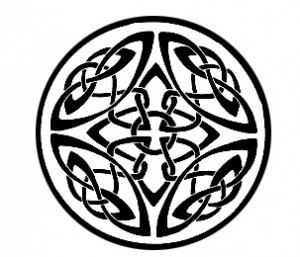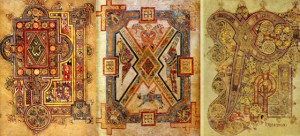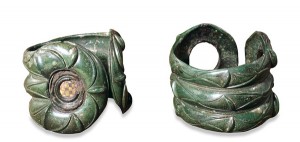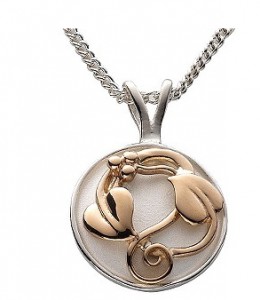The exact origins of Celtic design are somewhat impossible to determine, and are subject to wide and varied speculation. There are, however, certain facts that can be used to contextualise the characteristics and give them some bearing on what we understand to be ‘Celtic’ in style today.

The History of Celtic Jewellery Design
It is now widely accepted that Celtic style, or Insular art, started to emerge in the British Isles and Ireland from the fourth and fifth centuries and continued in their purest forms until the tenth and eleventh centuries. Certain peculiarities of design began to appear in Christian decoration, which can be found in the stonework of churches and tombstones, as well as metalwork (which included Celtic jewellery and armour) and religious manuscripts which had not been seen before. It is unclear exactly who began to execute them first, which has led to the term ‘Celtic’ being credited to both the Irish and the British.
What differentiates Celtic design from other styles of the era?
Firstly, there is a distinct lack of foliage, flowers and people as subjects. Previous to this, Acanthus leaves in particular were a popular subject for decoration but they are completely overlooked in Celtic art. (It’s not until you start to think about common themes in decorative art that you realise how significant this really is).
Secondly, the level of intricacy. The interlaced pattern work is detailed in every respect, to a degree not matched before. Geometric diagonal lines and spirals were entwined with strange monstrous animals and birds with interlocking tails and tongues. Styling became more curvilinear in a distinct move away from the previous rectilinear. Patterns were extremely complex and largely uninterrupted, leaving little space unused. The level of workmanship and skill required to achieve this standard of decoration was quite phenomenal.
The Book of Kells
One of the finest examples of Insular design is The Book of Kells, which was written in an Irish monastery around the time 800 AD. It contains four Gospels of the New Testament written in Latin, and currently resides in Trinity College Library in Dublin. It is an illuminated manuscript made of calfskin, elaborately decorated with intricate patterns we now recognise as typical of Celtic design. One of the key features was the initiating of each Gospel with a large, oversized letter (illuminated letter) which would occupy most of the page and was decorated in the most superb detail.
Previous to this, text would have been uniform in size with no distinction made between capital letters and the rest of the manuscript. This really was quite a change from what had been seen before.

The Book of Kells, although written much later than the original Celtic inception, has become one of the main sources of reference for Celtic design along with The Gospels of Lindisfarne and the Manuscripts of St Gall. You will find images from within them replicated over and over again on all things associated with Christian worship, from tombstones to stained glass windows, and of course jewellery.
The Heritage of Celtic Jewellery
It is easy to assume that all Celtic jewellery contains the same flat panels of decoration that we associate with the manuscripts and monuments of Christian worship previously mentioned. However, when you start to examine some of the authentic pieces of handmade Celtic jewellery discovered within hoards across the British Isles, you start to see quite quickly that this is not quite the case.
The Celts emerged within the Iron Age, which heralded a new wave of working techniques and materials, namely iron and steel, which required forging and working rather than simply casting. These new innovations gave rise to weapons, jewellery, utensils and armour which were lighter and stronger than during the previous Bronze Age.
The Torq
One of the most distinctive and notable items of Celtic, Iron Age jewellery is the metal torq, which in basic terms is a simple neck ring, otherwise known as a traditional Celtic necklace. Examples range from basic, undecorated iron rings, to elaborate twisted gold versions with cast, decorated terminals at either end. One of the finest examples was found in 1950 in Snettisham in Norfolk and has since become known as the Snettisham Great torq.
This particular torq was made from Electrum (a naturally occurring alloy of Gold and Silver). The main body of the Celtic torq was constructed from eight twisted strands of electrum, which were each made from another eight strands. The elaborate terminals at each end are hollow and cast with additional chased detail that would have been soldered on.
There is strong evidence to suggest that torqs were worn by all levels of society, particularly by women. But historians also believe that torqs were worn as battle dress too.
The Brooch
One of the most universal pieces of Celtic jewellery was the brooch. Celtic brooches have been found in burial sites across Europe and served both functional and decorative purposes as the Celtic jewellery was used as a cloak fastener on one or sometimes both shoulders. Examples have been found in gold, silver, iron and bronze. Most were cast and included a safety-pin mechanism, which is often used to date pieces, as it evolved over time. Subjects for brooches were varied, but a favourite theme was animals depicted as a whole or simply the head.
Other popular items of Celtic jewellery included bracelets, which were worn on each wrist, anklets, again one on each ankle and also armlets. Armlets are quite an interesting extension of the bracelet and have only ever been found in Scotland. They tend to be cast in bronze as a complete piece and decorated with enamels or coloured glass.

Modern Celtic Style Jewellery
It’s clear to see that the original Celtic jewellery of the era is a far cry from replicas you might find on sale today, which tend to focus on the more two dimensional decorative elements. There are, however, some companies who are managing to combine the old and the new to great effect.

It has proven quite a task unravelling the fine details of Celtic design and how it has evolved to become an intrinsic part of popular jewellery design, but we hope you are now as intrigued as we are to delve deeper and discover more of this fascinating style of decorative art.
If you’ve made any Celtic jewellery or are currently working on some, be sure to share your creations with us on social media, tagging in Cooksongold on Facebook, Twitter and Instagram
Sources:
The Grammar of Ornament – Owen Jones
7000 Years of Jewellery – Edited by Hugh Tait

Cooksongold
